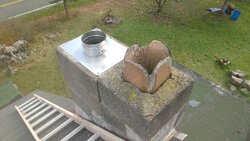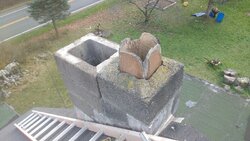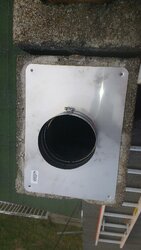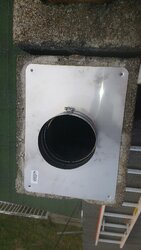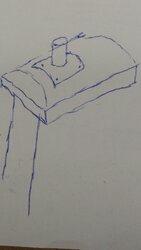I have a liner kit ordered with insulation and flat top plate (13x18 to fit the block) and the clay tiles are coming out. I'm still trying to figure out how to mount the top plate on my chimney block chimney. There are two side by side, but I'm currently only working on one. I know a poured in place crown would be ideal but I may take the 13x18 down eventually and replace with 13x13 to make room for a window it was built in front of, so I'm hesitant to pour a crown over both flues. I'm looking for suggestions on an easy crown that will last 5-10 years.
The top plate could be mounted directly to the chimney block with some sheet metal capping the unused flue, but I'm not sure if that will shed water appropriately...
The previous crown was clay liner in concrete chimney block with cracked/detached mortar stabilizing the clay in the block. The two chimneys do not seem to be attached to each other with anything but a little mortar in between. Originally I was going to leave the clay tiles in, but they were so loose I decided to take them out and make room for a full 6" insulated liner.
I don't have any pics of the current crown, but some pics of the general layout can be seen here https://www.hearth.com/talk/threads/chimney-across-a-window-repair-or-replace.157041/#post-2107225
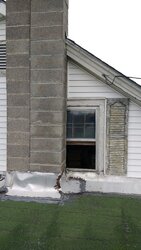
The top plate could be mounted directly to the chimney block with some sheet metal capping the unused flue, but I'm not sure if that will shed water appropriately...
The previous crown was clay liner in concrete chimney block with cracked/detached mortar stabilizing the clay in the block. The two chimneys do not seem to be attached to each other with anything but a little mortar in between. Originally I was going to leave the clay tiles in, but they were so loose I decided to take them out and make room for a full 6" insulated liner.
I don't have any pics of the current crown, but some pics of the general layout can be seen here https://www.hearth.com/talk/threads/chimney-across-a-window-repair-or-replace.157041/#post-2107225




